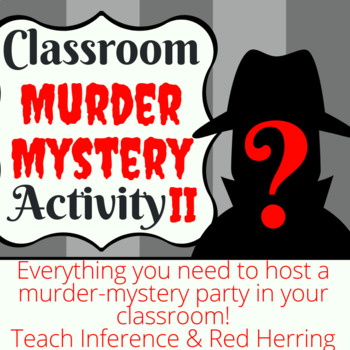Classroom Murder Mystery Activity II
- Zip
What educators are saying
Also included in
- Engage your students in murder mystery games in the classroom throughout the year with this bundle of my best-selling mysteries!There are many opportunities throughout the year to use these mysteries: Before, during, or after a mystery unitAs a class rewardAs an icebreaker at the beginning of the yePrice $34.00Original Price $42.50Save $8.50
Description
*Updated! Now includes virtual option an alternate version so one class won't give spoilers to another.
Engage your students in a murder mystery game in the classroom!
I use this lesson before starting my mystery unit and the students love it. They enjoy taking on the roles of the characters, and they enjoy the competition and challenge of trying to identify the murderer.
This is not a sequel to the original murder mystery product. This mystery includes brand new characters and a new setting!
Product Description
This product includes:
-An introduction sheet with the background of the incident: while on a field trip to a garden museum, one student was found dead in a fountain with a large gash on the back of his head. All of the suspects (your students) are rounded up and on the bus about to head back to school. The suspects start their own investigations while they are waiting.
-15 character cards that detail how the person knows the victim, where they were during the incident, and any other pertinent information (including lots of red herrings). This activity works well with class sizes of 12-30. Any class over 15 can double up two students to one character. There are also three characters who can be removed from the set and the story will still make sense.
Idea from a customer on how to use this with smaller classes or teaching virtually: "For those with smaller classes, I did this with a class of 9 students. I tried to assign what I felt were the most important players to the students in my class, and then I used Flipgrid to record interviews with the other personas. I pasted QR codes from Flipgrid around the room so students could hear from the others involved."
-A copy of a map of the garden museum so students can keep track of who was where when the incident occurred.
-A notes sheet to detail the different characters, motives, and alibis.
-An assessment sheet. Students must detail a few characters who are innocent, a red herring, and of course who the assailant is. For each they need to explain what clues support their answer.
An engaging way to focus on inferences, characterization, and motive!
This is the second murder mystery in my store. The original can be found here: Classroom Murder Mystery Activity. I also have a middle school version, Middle School Classroom Mystery, where someone's art project was vandalized and students work to figure out who did it.






